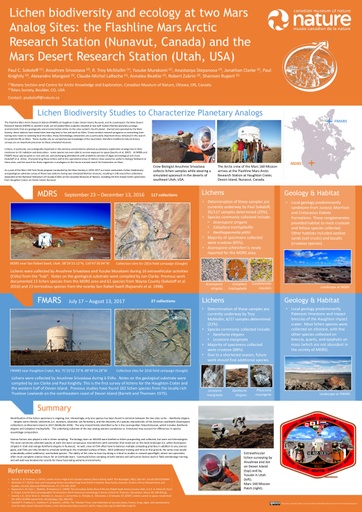pdf Lichen biodiversity and ecology at two Mars Analog Sites: the Flashline Mars Arctic Research Station (Nunavut, Canada) and the Mars Desert Research Station (Utah, USA) Popular
3114 downloads

Paul Sokoloff
Canadian Museum of Nature
Srivastava, Anushree, Mars Society, Lakewood, United States of America
McMullin, R. Troy, Canadian Museum of Nature, Ottawa, Canada
Murakami, Yusuke, Mars Society, Lakewood, United States of America
Stepanova, Anastasiya, Mars Society, Lakewood, United States of America
Clarke, Jonathan, Mars Society, Lakewood, United States of America
Knightly, Paul, Mars Society, Lakewood, United States of America
Mangeot, Alexandre, Mars Society, Lakewood, United States of America
LaRoche, Claude-Michel, Mars Society, Lakewood, United States of America
Beattie, Annalea, Mars Society, Lakewood, United States of America
Zubrin, Robert, Mars Society, Lakewood, United States of America
Rupert, Shannon, Mars Society, Lakewood, United States of America
 The Flashline Mars Arctic Research Station (FMARS) at Haughton Crater, Devon Island, Nunavut, and its counterpart, the Mars Desert Research Station (MDRS) in southern Utah, are simulated Mars outposts situated at two well-known Martian planetary analogs - environments that are geologically and environmental similar to the solar system’s fourth planet. Owned and operated by the Mars Society, these stations host researchers learning how to live and work on Mars. Crews conduct research programs on everything from testing new rovers to isolating local microbes; these Astrobiology simulations are a particularly important dress-rehearsal in the search for potential life on Mars. These studies rely on comprehensive knowledge of the local biota, therefore traditional natural history surveys are an important component of these mock missions. As a part of the Mars 160 Twin Study program conducted by the Mars Society in 2016-2017 our team conducted a lichen biodiversity survey of these two stations during two simulated Martian missions, resulting in 146 new lichen collections deposited at the National Herbarium of Canada (CANL) at the Canadian Museum of Nature. We will highlight the results of this first taxonomic lichen survey of Haughton Crater, an important field site in the Canadian High Arctic.
The Flashline Mars Arctic Research Station (FMARS) at Haughton Crater, Devon Island, Nunavut, and its counterpart, the Mars Desert Research Station (MDRS) in southern Utah, are simulated Mars outposts situated at two well-known Martian planetary analogs - environments that are geologically and environmental similar to the solar system’s fourth planet. Owned and operated by the Mars Society, these stations host researchers learning how to live and work on Mars. Crews conduct research programs on everything from testing new rovers to isolating local microbes; these Astrobiology simulations are a particularly important dress-rehearsal in the search for potential life on Mars. These studies rely on comprehensive knowledge of the local biota, therefore traditional natural history surveys are an important component of these mock missions. As a part of the Mars 160 Twin Study program conducted by the Mars Society in 2016-2017 our team conducted a lichen biodiversity survey of these two stations during two simulated Martian missions, resulting in 146 new lichen collections deposited at the National Herbarium of Canada (CANL) at the Canadian Museum of Nature. We will highlight the results of this first taxonomic lichen survey of Haughton Crater, an important field site in the Canadian High Arctic.

